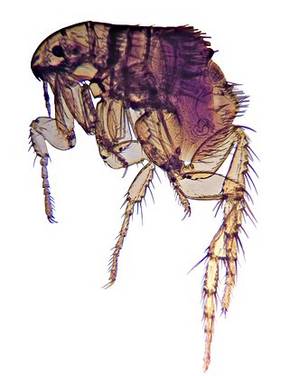The Flea Life Cycle

Fleas pass through a four-stage life cycle consisting of egg, larva, pupa and adult. They undergo a metamorphosis just like caterpillars turning into butterflies, though adult fleas are less attractive than butterflies and much more annoying.
The time it takes to complete the life cycle from egg to adult varies from two weeks to eight months, depending on the temperature, humidity and the amount of food available.
A typical flea population consists of 50 per cent eggs, 35 per cent larvae, ten per cent pupae and only five per cent adults. Only adult fleas live on pets. The rest are in the environment, so the number visible on your pet is only the tip of the iceberg.
Adults are usually 1/16th to 1/8th of an inch long, red-brown in color and have three pairs of legs, the last pair quite large and well adapted for jumping. Fleas are wingless. Their bodies are flattened laterally and covered with a hard external coating, like a skeleton, on the outside. This is shiny, which helps them to move through the fur of the cat or dog and the hardness helps prevent squashing.
Adult fleas are blood-sucking parasites with mouth parts especially designed to pierce a host and suck out its blood. When they first hatch, adult fleas have one immediate priority: eating. Most survive only a week without feeding, but some can survive for 20 to 62 days before feeding if conditions are conducive. Once they have had a sufficient meal of blood, they mate.
They will not breed for at least the first 24 to 36 hours after emerging from the cocoon, but most females will breed and begin to lay eggs within the first week. Egg output peaks after three to nine days. After a blood meal, the female flea lays an average of 20 to 30 eggs per day.
|
"In just 30 days, ten female fleas under ideal conditions can multiply to more than a quarter of a million new
fleas in different life stages."
|
Female fleas need to keep feeding on blood to ensure their metabolism stays in balance while they are laying eggs. Adults on a host animal can live for 133 days, but if they become dislodged they need to rapidly find a new host, or quickly hop back onto the original host. They die within four days of losing their host.
In just 30 days, ten female fleas under ideal conditions can multiply to more than a quarter of a million new fleas in different life stages.
Eggs are loosely laid in the hair coat of your pet. They are wet and sticky when first produced but dry out and usually drop from an animal within a few hours. (More than 70 per cent fall off within eight hours of being laid).
|
Anti-flea treatments
|
Pet Shed's most popular solutions for ridding your pet of fleas
|
Flea eggs resemble tiny chicken eggs. They are oval-shaped and white in color, but quite shiny and are only 0.5mm x 0.3mm in size. Eggs can fall almost anywhere but particularly where the pet rests or sleeps, such as on rugs, carpets, furniture, dog beds, kennels or under trees.
The time taken to hatch is totally dependent on environmental factors, with the ideal temperature being around 77�F. Eggs can dry out and die, so like all the other life stages they need high humidity. Freezing conditions will also kill eggs, so those laid outdoors in the fall may not survive the winter in colder areas.
Eggs hatch into larvae and look a little like spiny earthworms - about 0.25in long� with no legs but a big mouth. They start life a white colour, but quickly turn brown after feeding on adult flea feces (digested blood from the host cat or dog which drops off the host with the eggs).
The lack of legs means that larvae cannot move very far from the place they emerge from the egg. They need a protected environment with moderate temperatures and high humidity. Larvae are attracted to dark places. They are normally found indoors in floor cracks and crevices, along baseboards, under rug edges, deep in carpet pile and in furniture or beds.

Larvae must feed quickly in order to survive; unfed they die in three days. On average, larvae take between a week to 12 days to fully develop, molting through three larval stages.
Once fully developed, they weave themselves a silken cocoon in which they pupate. Pupae are sticky and whitish in color. Pet hair, carpet fibers, dust, grass cuttings and other debris stick to the pupae and help camouflage them.
There are three stages of metamorphosis within the cocoon, the last being a pre-emerged adult. Pupae are hardier than larvae but are still susceptible to drying out in low humidity, as well as to insecticides. Ideal climates are 80�F with more than 50 per cent humidity.
|
"When they first hatch, adult fleas have one immediate priority: eating."
|
Pupation takes between five and 14 days, however pre-emerged adult fleas may remain resting in the cocoon for a prolonged period until conditions are more appropriate. Pupae can survive a cold winter or a very hot summer in a state similar to a hibernation, commonly referred to as 'overwintering.' They can remain in this stage for up to six months without feeding.
The detection of pressure (such as a host animal walking past or lying down on them) or heat of 90 to 100�F (the body temperature of a dog or cat is around 101�F, but the fur is a little cooler) stimulates the adults to emerge from their cocoons. Many heated homes are warm enough for the flea life cycle to continue year-round without the need for overwintering.

Families returning from vacation often trigger a wave of flea emergence. The house has been empty with no hosts for fleas to feed on, so the adults have died out. However flea eggs have hatched and the larvae have pupated. New adult fleas have fully developed inside the pupal cocoon but remained in hibernation, awaiting the trigger for emergence. Unfortunately for the returning family, they are greeted by hundreds of hungry fleas.
Good flea control means controlling not only the adult fleas visible on a pet, as they are only a small part of the flea population. It also means controlling the immature stages, such as eggs, larvae and pupa in the environment to reduce the overall population. Your veterinarian can recommend the most appropriate flea control for your pet.
|
References
|
| Lyon, WF (1997). Fleas. Ohio State University Extension Fact Sheet. http://ohioline.osu.edu |